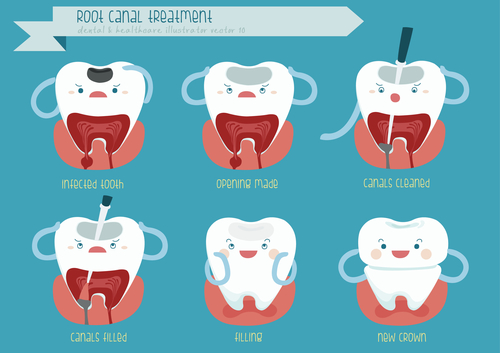Understanding the Causes of Root Canal Failure
Have you ever wondered why some root canals fail to provide long-term relief? Well, let’s take a closer look at the causes of root canal failure.
It’s important to understand that root canal treatment is a complex procedure aimed at saving a severely damaged tooth. However, despite advancements in dental techniques, a number of factors can contribute to the failure of a root canal.
From inadequate cleaning and shaping to persistent infections, there are several potential reasons why your root canal may not be successful.
So, if you’ve ever experienced a root canal failure or are simply curious about the factors that can lead to it, keep reading to uncover the mysteries behind this dental conundrum.
Inadequate Cleaning and Shaping
Inadequate cleaning and shaping during a root canal procedure can significantly contribute to the failure of the treatment. When the dentist fails to thoroughly clean the infected pulp and shape the canals properly, it can leave behind bacteria and debris. This can lead to persistent infection and reinfection, as well as the formation of new bacteria colonies. Inadequate cleaning and shaping can also result in incompletely filled canals, leaving spaces for bacteria to multiply and cause further damage.
During the cleaning phase of a root canal, the dentist removes the infected pulp and disinfects the canals. This step is crucial in eliminating bacteria and preventing reinfection. However, if the dentist fails to remove all the infected tissue or misses certain canals, it can result in persistent infection and treatment failure.
Similarly, the shaping of the canals is essential for successful root canal treatment. The dentist must shape the canals to allow for proper filling and sealing. If the canals aren’t shaped adequately, they may not be completely filled with the filling material. This allows bacteria to survive and multiply, leading to reinfection and treatment failure.
Persistent Infections
Persistent infections can be a significant factor in the failure of a root canal treatment. Despite the dentist’s best efforts to clean and shape the root canal system, some bacteria may remain in the tooth. These residual bacteria can multiply and cause a persistent infection, leading to treatment failure.
One of the main reasons for persistent infections is the complexity of the root canal system. The canals within the tooth can be intricate, with many branches and accessory canals. It can be challenging to reach all these areas and thoroughly clean them. Even with advanced techniques and instruments, it’s possible for bacteria to hide in hard-to-reach places, making complete eradication difficult.
Another factor that can contribute to persistent infections is the presence of microorganisms that are resistant to the disinfectants used during the root canal procedure. Some bacteria have developed mechanisms to withstand the effects of common disinfecting agents, allowing them to survive and continue causing infection.
Additionally, inadequate sealing of the root canal can also lead to persistent infections. If the filling material used to seal the canals doesn’t completely fill the space or if there are gaps and voids, bacteria can penetrate and colonize the area, leading to reinfection.
To prevent persistent infections, it’s crucial to choose an experienced dentist who uses advanced techniques and technology to ensure thorough cleaning and shaping of the root canal system. Proper disinfection and meticulous sealing of the canals are also essential to minimize the risk of treatment failure.
Structural Damage
To address the issue of root canal failure caused by persistent infections, it’s important to examine the potential impact of structural damage on the success of the treatment.
Structural damage refers to any physical disruption or deterioration of the tooth, such as cracks, fractures, or loss of tooth structure. When the tooth’s structure is compromised, it can lead to a higher risk of root canal failure.
Structural damage can occur due to various reasons, including trauma, decay, or previous dental treatments. For example, a tooth that has experienced a significant impact or injury may develop cracks or fractures that can compromise the integrity of the tooth. Additionally, extensive tooth decay can weaken the structure of the tooth, making it more prone to further damage. Even previous dental treatments, such as large fillings or crowns, can weaken the tooth structure and increase the risk of root canal failure.
The presence of structural damage can hinder the success of root canal treatment in multiple ways. Firstly, it can make it more challenging for the dentist to thoroughly clean and seal the root canal system. Cracks or fractures can act as pathways for bacteria to enter the tooth, leading to persistent infections. Secondly, compromised tooth structure can affect the long-term stability of the tooth, making it more susceptible to future fractures or breakages.
Root Canal Recontamination
After undergoing a root canal treatment, it’s crucial to address the possibility of root canal recontamination. Despite the thorough cleaning and disinfection during the initial procedure, there’s still a chance for bacteria to reenter the treated tooth and cause infection.
The primary cause of root canal recontamination is the failure to properly seal the tooth after the initial treatment. If the temporary filling or crown isn’t placed immediately after the root canal, bacteria can easily invade the tooth and reinfect the root canal system.
Additionally, if the permanent filling or crown isn’t properly sealed or if there’s a leakage over time, bacteria can also reenter the tooth and cause reinfection. It’s essential to ensure that the tooth is adequately sealed to prevent recontamination.
Regular check-ups with your dentist are crucial to monitor the condition of the tooth and address any signs of recontamination promptly. Proper oral hygiene, such as brushing and flossing regularly, can also help reduce the risk of recontamination by keeping the area around the treated tooth clean and free from bacteria.
Missed Canals
You may be surprised to learn that even the most experienced dentists can overlook canals during a root canal procedure. These overlooked canals can harbor bacteria and cause reinfection, leading to root canal failure.
Additionally, accessory canals, which are smaller canals branching off from the main canal, may also be missed and left untreated, further contributing to the failure of the root canal treatment.
Overlooked Canals
One common cause of root canal failure is the oversight of canals during the initial treatment. This happens when a dentist fails to locate and treat all the canals within a tooth. Overlooking canals can lead to persistent infection, as bacteria can continue to thrive in the untreated canals. To prevent this from happening, it’s important for dentists to thoroughly examine and diagnose the tooth before starting the root canal procedure.
Here are three reasons why canals may be overlooked:
1. Complexity of tooth anatomy: Teeth can have intricate canal systems that are difficult to visualize and treat. This complexity increases the chances of missing canals.
2. Inadequate imaging techniques: If the dentist relies on outdated or low-quality imaging techniques, it can be challenging to accurately identify all the canals.
3. Lack of experience: Inexperienced dentists may not have the necessary skills or knowledge to locate and treat all the canals effectively.
To ensure the success of a root canal treatment, it’s crucial for dentists to be meticulous in their examination and treatment planning, using advanced imaging techniques and seeking assistance from specialists if needed.
Untreated Accessory Canals
When canals are overlooked during the initial treatment, another common cause of root canal failure arises – untreated accessory canals, also known as missed canals. These accessory canals are tiny pathways that branch off from the main root canal and may contain nerves and blood vessels. If these canals aren’t properly identified and treated, they can become a breeding ground for bacteria, leading to infection and potential reinfection of the tooth.
Missed canals are often difficult to detect as they can be hidden within the tooth’s complex anatomy. Therefore, it’s crucial for dentists to have excellent knowledge and skill in identifying and treating these accessory canals to ensure the success of the root canal treatment.
Regular follow-ups and X-rays can also help to detect any missed canals and address them promptly, preventing future complications.
Improper Restoration
Improper restoration can lead to root canal failure if the tooth isn’t properly sealed and protected. When a root canal treatment is performed, it’s crucial to restore the tooth effectively to ensure its long-term success. Here are three reasons why improper restoration can result in root canal failure:
1. Inadequate filling: If the root canals aren’t completely filled with the dental material, bacteria can re-enter the tooth and cause reinfection. This can happen if the dentist fails to properly clean and shape the canals or if the filling material doesn’t reach the apex of the roots.
2. Weak restoration: A weak or poorly placed filling or crown can compromise the structural integrity of the tooth. This can make the tooth susceptible to fractures or recontamination, leading to the failure of the root canal treatment.
3. Delayed restoration: If the tooth isn’t promptly restored after the root canal treatment, it becomes vulnerable to bacterial contamination. Without a protective restoration, bacteria can enter the canals and cause reinfection, undoing the benefits of the root canal procedure.
To ensure the success of a root canal treatment, it’s essential to choose a qualified dentist who can perform proper restoration techniques, including thorough cleaning, shaping, and sealing of the canals, as well as the placement of a strong and timely restoration.
Patient Non-Compliance
When it comes to root canal failure, patient non-compliance plays a significant role. Lack of follow-through, such as missing scheduled appointments or failing to complete recommended treatments, can hinder the success of the procedure.
Disregarding post-treatment instructions, such as avoiding certain foods or neglecting to take prescribed medications, can also lead to complications.
Additionally, neglecting proper oral hygiene, such as brushing and flossing regularly, can contribute to the failure of a root canal.
Lack of Follow-Through
Patients who don’t comply with the recommended follow-up appointments and oral care instructions are at risk of experiencing root canal failure. Lack of follow-through can have serious consequences and can undermine the success of the root canal procedure.
Here are three reasons why patient non-compliance can lead to root canal failure:
1. Incomplete healing: Regular follow-up appointments are crucial for monitoring the healing process. If you miss these appointments, your dentist won’t be able to identify any potential issues or make necessary adjustments. This can result in incomplete healing and the recurrence of infection.
2. Reinfection: Proper oral care instructions, including brushing, flossing, and using antibacterial mouthwash, are provided after a root canal procedure. Failure to follow these instructions increases the risk of reinfection, as harmful bacteria can thrive and cause further damage.
3. Complications: Without regular check-ups, complications such as fractures, decay, or abscesses may go unnoticed. These issues can worsen over time and compromise the success of the root canal.
Disregarding Post-Treatment Instructions
To ensure the success of your root canal procedure, it’s crucial to diligently follow the post-treatment instructions provided by your dentist. Disregarding these instructions can greatly increase the risk of root canal failure.
Your dentist will provide specific guidelines tailored to your individual case, including how to care for the treated tooth and what to avoid. Failure to follow these instructions can lead to complications such as infection, reinfection, and even the need for additional treatment.
Some common mistakes patients make include not taking prescribed antibiotics, not avoiding hard or sticky foods, and not practicing good oral hygiene.
Neglecting Oral Hygiene
Neglecting oral hygiene can significantly contribute to the failure of a root canal procedure. Proper oral hygiene is crucial in maintaining the health of your teeth and gums, especially after undergoing a root canal.
Here are three reasons why neglecting oral hygiene can lead to root canal failure:
1. Plaque and bacteria buildup: Failure to brush and floss regularly allows plaque and bacteria to accumulate around the treated tooth. This can lead to reinfection and further damage to the tooth structure.
2. Gum disease: Neglecting oral hygiene can increase the risk of developing gum disease. Gum disease can cause inflammation and infection around the root canal-treated tooth, leading to failure of the procedure.
3. Tooth decay: Without regular brushing and flossing, tooth decay can occur in other areas of your mouth. This decay can spread to the root canal-treated tooth and compromise its success.
Frequently Asked Questions
What Are the Common Signs and Symptoms of Inadequate Cleaning and Shaping During a Root Canal Procedure?
If you’re wondering about the common signs and symptoms of inadequate cleaning and shaping during a root canal procedure, there are a few things to look out for.
You might experience persistent pain or discomfort in the treated tooth, swelling or tenderness in the surrounding gums, or even the return of infection or abscesses.
It’s important to address these issues promptly with your dentist to avoid further complications and ensure the success of your root canal treatment.
Can Persistent Infections After a Root Canal Be Treated With Antibiotics Alone, or Is Retreatment Necessary?
Persistent infections after a root canal may not always be effectively treated with antibiotics alone. In some cases, retreatment may be necessary to fully address the issue. Antibiotics can help reduce the infection, but they may not completely eliminate it.
Retreatment involves cleaning and shaping the root canal again to remove any remaining infection. This allows for better healing and reduces the risk of further complications.
Consulting with your dentist is essential to determine the most appropriate course of action.
How Does Structural Damage to the Tooth Affect the Success of a Root Canal Treatment?
Structural damage to your tooth can significantly impact the success of a root canal treatment. When a tooth is damaged, it can compromise the integrity of the canal system, making it difficult to completely clean and seal the canals.
This can lead to persistent infection or reinfection, hindering the effectiveness of the root canal. It’s important to address any structural damage before undergoing a root canal procedure to ensure the best possible outcome.
What Are the Potential Causes of Root Canal Recontamination After a Successful Treatment?
After a successful root canal treatment, you may wonder what could cause recontamination.
Several potential factors can lead to this issue. One possible cause is inadequate cleaning and shaping of the root canal system, leaving behind bacteria.
Another factor is the presence of untreated canals or missed canals during the initial treatment.
Additionally, a cracked or poorly sealed restoration can allow bacteria to enter the root canal system.
It’s crucial to address these causes to prevent root canal recontamination.
How Often Do Dentists Miss Canals During a Root Canal Procedure, and What Are the Consequences of This?
How often do dentists miss canals during a root canal procedure, and what’re the consequences of this?
Missing canals during a root canal procedure can happen occasionally, but it’s not very common. When a canal is missed, it can lead to persistent infection, pain, and the need for additional treatment.
It’s important for dentists to thoroughly examine the tooth and use appropriate imaging techniques to ensure all canals are treated. Proper identification and treatment of all canals is crucial for a successful root canal procedure.
Conclusion
So, in conclusion, there are several factors that can contribute to the failure of a root canal procedure. These include:
– Inadequate cleaning and shaping of the root canal
– Persistent infections
– Structural damage
– Recontamination of the root canal
– Missed canals
– Improper restoration
– Patient non-compliance
< Clicking Here p>It’s important for both dentists and patients to be aware of these causes in order to prevent root canal failure and ensure successful outcomes.

Welcome to my website! I am Patrick Oxenham, a dedicated and passionate Pediatric Dentist with years of experience in providing comprehensive dental care for children. I am thrilled to share my knowledge and expertise in smile restoration methods, aesthetic dentistry updates, and gum health and grafting with you.

